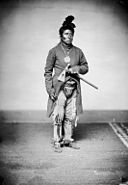The Massacre Canyon Battle took place on August 5, 1873, in Hitchcock County, Nebraska. It was one of the last battles between the Pawnee and the Sioux and the last large-scale battle between Native American tribes in the area of the present-day United States of America.[1] The battle occurred when a combined Oglala/Brulé Sioux war party of over 1000 warriors attacked a party of Pawnee on their summer buffalo hunt. According to Indian agent John W. Williamson, who accompanied the hunting party, "On the 2d day of July, 1873, the Indians, to the number of 700, left Genoa for the hunting grounds. Of this number 350 were men, the balance women and children."
The Pawnee were traveling along the west bank of the canyon, which runs south to the Republican River, when they were attacked. Sixty-nine Pawnee were killed, most of whom were non-combatant women and children.[2] This massacre was one of the factors that led to the Pawnees' decision to move to a reservation in Indian Territory in what is today Oklahoma.[3] Principal chiefs at the battle were:
- Pawnee: Sky Chief, Sun Chief, Fighting Bear, Ruling His Son.
- Sioux: Spotted Tail (Brulé chief), Little Wound (Oglala chief), Two Strike (Brulé chief). Chief Charging Bear (John Grass, Sihasapa).
Among the Pawnee dead were the wife and four children of Traveling Bear, a former sergeant in the Pawnee Scouts who served under Major Frank North and a Medal of Honor recipient.[4]
Agent Williamson's Account[]
John Williamson (23), was assigned as the Pawnee agent at the Genoa Agency, the Pawnee reservation, and accompanied the Pawnee on their hunt.
"On the fourth day of August we reached the north bank of the Republican River and went into camp. At 9 o'clock that evening, three white men came into camp and reported to me that a large band of Sioux warriors were camped 25 miles [40 km] northwest, waiting for an opportunity to attack the Pawnees for several days, anticipating that we would move up the river where buffaloes were feeding. Previous to this, white men visited us and warned us to be on our guard against Sioux attacks, and I was a trifle skeptical as to the truth of the story told by our white visitors. But one of the men, a young man about my age at the time, appeared to be so sincere in his efforts to impress upon me that the warning should be heeded, that I took him to Sky Chief who was in command that day, for a conference. Sky Chief said the men were liars; that they wanted to scare the Pawnees away from the hunting grounds so that white men could kill buffaloes for hides. He told me I was squaw and a coward. I took exception to his remarks, and retorted: 'I will go as far as you dare go. Don't forget that.'
"The following morning August 5, we broke camp and started north, up the divide between the Republican and the Frenchman Rivers. Soon after leaving camp, Sky Chief rode up to me and extending his hand said, 'Shake, brother.' He recalled our little unpleasantness the night previous and said he did not believe there was cause for alarm, and was so impressed with the belief that he had not taken the precaution to throw out scouts in the direction the Sioux were reported to be. A few minutes later a buffalo scout signaled that buffaloes had been sighted in the distance, and Sky Chief rode off to engage in the hunt. I never saw him again. He had killed a buffalo and was skinning it when the advance guard of the Sioux shot and wounded him. The Chief attempted to reach his horse, but before he was able to mount, several of the enemy surrounded him. He died fighting. A Pawnee, who was skinning a buffalo a short distance away, but managed to escape, told me how Sky Chief died."
Monument[]

Massacre Canyon Monument
The Massacre Canyon Monument was dedicated on Sept. 26, 1930. It was the first historical monument erected in Nebraska by federal grant. It stands on a three-acre (1.2 ha) plot, three miles (4.8 km) east of Trenton off U.S. Route 34, after having been moved from its original location overlooking the Republican River valley. The monument was constructed from Minnesota pink granite from a quarry in St. Cloud. The shaft of the obelisk is 35 feet (11 m) high. The base measures 9 feet (2.7 m) by 9.5 feet (2.9 m) across; the bottom of the shaft is five feet (1.5 m) across, tapering to 32 inches (81 cm) near the top. The entire monument weighs 91 tons (83,000 kg).
The monument is located in a small park area with picnic tables and a visitor center that features exhibits about early pioneers, the tribal customs of the Sioux and the Pawnee people and a gift shop.
Gallery[]
Pawnee chief
See also[]
References[]
- ↑ The Nebraska Indian Wars reader, 1865-1877 By R. Eli Paul p.88 Publisher: University of Nebraska Press (April 1, 1998) Language: English ISBN 0-8032-8749-6
- ↑ The Chicago Tribune, Saturday, August 30, 1873; New York Times, August 21, 1873 (reported by William Burgess, Pawnee Indian agent)
- ↑ Massacre Along the Medicine Road: A Social History of the Indian War of 1864, p. 389, By Ronald Becher. Publisher: Caxton Press (March 1, 1999) Language: English ISBN 0-87004-387-0
- ↑ Medal of honor: historical facts & figures By Ron Owens p.52
Bibliography[]
- Boughter, Judith A. The Pawnee Nation: An Annotated Research Bibliography (Lanham, MD: Scarecrow Press), 2004. ISBN 0-8108-4990-9
External links[]
- Massacre Canyon Monument
- LAST BUFFALO HUNT OF THE PAWNEES By John W. Williamson
- "Massacre Canyon saga is just one story in a rich Native American history in Nebraska" - Nebraska Rural Living article
- Massacre Canyon Monument and Visitor Center - Visit Nebraska
The original article can be found at Massacre Canyon and the edit history here.




